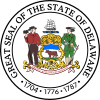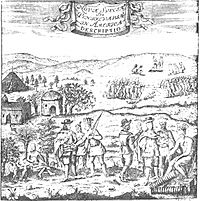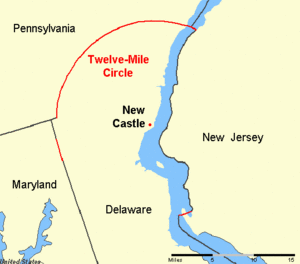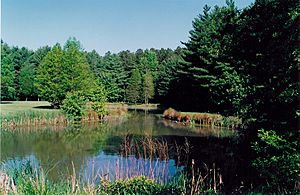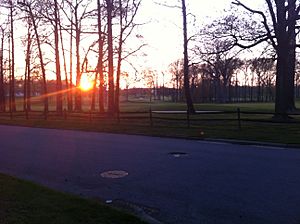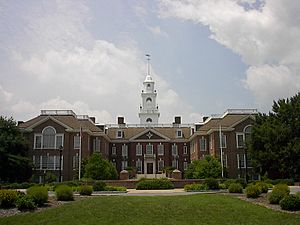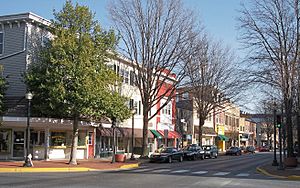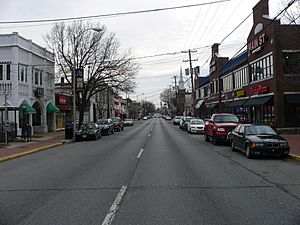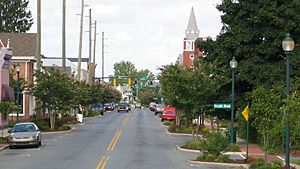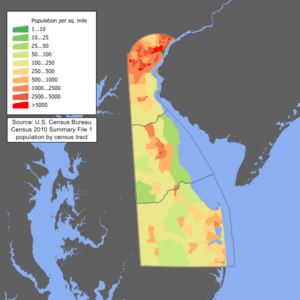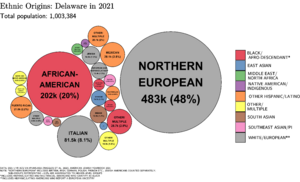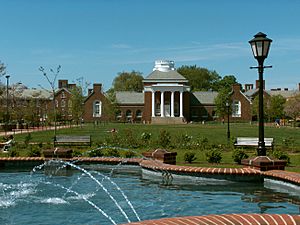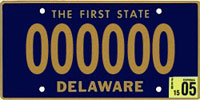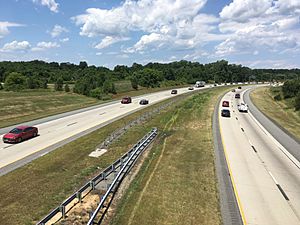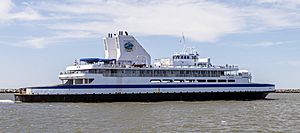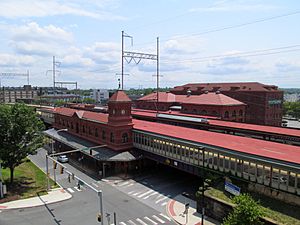Delaware facts for kids
Quick facts for kids
Delaware
|
|||
|---|---|---|---|
|
|||
| Nickname(s):
The First State; The Small Wonder; Blue Hen State; The Diamond State
|
|||
| Motto(s):
Liberty and Independence
|
|||
| Anthem: "Our Delaware" | |||
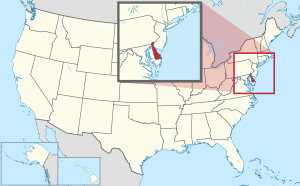
Location of Delaware within the United States
|
|||
| Country | United States | ||
| Before statehood | Delaware Colony, New Netherland, New Sweden | ||
| Admitted to the Union | December 7, 1787 (1st) | ||
| Capital | Dover | ||
| Largest city | Wilmington | ||
| Largest county or equivalent | New Castle | ||
| Largest metro and urban areas | Delaware Valley | ||
| Legislature | General Assembly | ||
| • Upper house | Senate | ||
| • Lower house | House of Representatives | ||
| Judiciary | Delaware Supreme Court | ||
| U.S. senators | Chris Coons (D) Lisa Blunt Rochester (D) |
||
| U.S. House delegation | Sarah McBride (D) (list) | ||
| Area | |||
| • Total | 2,489 sq mi (6,450 km2) | ||
| Area rank | 49th | ||
| Dimensions | |||
| • Length | 96 mi (154 km) | ||
| • Width | 30 mi (48 km) | ||
| Elevation | 60 ft (20 m) | ||
| Highest elevation
(Near the
Ebright Azimuth) |
447.85 ft (136.50468 m) | ||
| Lowest elevation
(Atlantic Ocean)
|
0 ft (0 m) | ||
| Population
(2024)
|
|||
| • Total | |||
| • Rank | 45th | ||
| • Density | 491/sq mi (190/km2) | ||
| • Density rank | 6th | ||
| • Median household income | $81,400 (2023) | ||
| • Income rank | 19th | ||
| Demonym(s) | Delawarean | ||
| Language | |||
| • Official language | None | ||
| Time zone | UTC−05:00 (EST) | ||
| • Summer (DST) | UTC−04:00 (EDT) | ||
| USPS abbreviation |
DE
|
||
| ISO 3166 code | US-DE | ||
| Traditional abbreviation | Del. | ||
| Latitude | 38° 27′ N to 39° 50′ N | ||
| Longitude | 75° 3′ W to 75° 47′ W | ||
| Bird | Delaware Blue Hen |
|---|---|
| Fish | Weakfish |
| Flower | Peach blossom |
| Tree | American holly |
| Insect | 7-spotted ladybug |
Delaware (![]() i/ˈdɛləwɛər/ del-Ə-wair) is a state in the Mid-Atlantic and Northeastern region of the United States. It borders Maryland to its south and west, Pennsylvania to its north, New Jersey to its northeast, and the Atlantic Ocean to its east. The state's name derives from the adjacent Delaware Bay, which in turn was named after Thomas West, 3rd Baron De La Warr, an English nobleman and the Colony of Virginia's first colonial-era governor.
i/ˈdɛləwɛər/ del-Ə-wair) is a state in the Mid-Atlantic and Northeastern region of the United States. It borders Maryland to its south and west, Pennsylvania to its north, New Jersey to its northeast, and the Atlantic Ocean to its east. The state's name derives from the adjacent Delaware Bay, which in turn was named after Thomas West, 3rd Baron De La Warr, an English nobleman and the Colony of Virginia's first colonial-era governor.
Delaware occupies the northeastern portion of the Delmarva Peninsula, and some islands and territory within the Delaware River. It is the 2nd smallest and 6th least populous state, but also the 6th most densely populated. Delaware's most populous city is Wilmington, and the state's capital is Dover, the 2nd most populous city in Delaware. The state is divided into three counties, the fewest number of counties of any of the 50 U.S. states; from north to south, the three counties are: New Castle County, Kent County, and Sussex County. The southern two counties, Kent and Sussex counties, historically have been predominantly agrarian economies. New Castle is more urbanized and is considered part of the Delaware Valley metropolitan statistical area that surrounds and includes Philadelphia, the nation's sixth most populous city. Delaware is considered part of the Southern United States by the U.S. Census Bureau, but the state's geography, culture, and history are a hybrid of the Mid-Atlantic and Northeastern regions of the country.
Before Delaware coastline was explored and developed by Europeans in the 16th century, the state was inhabited by several Native American tribes, including the Lenape in the north and Nanticoke in the south. The state was first colonized by Dutch traders at Zwaanendael, near present-day Lewes, Delaware, in 1631. Delaware was one of the Thirteen Colonies that participated in the American Revolution and American Revolutionary War, in which the American Continental Army, led by George Washington, defeated the British, ended British colonization and established the United States as a sovereign and independent nation. On December 7, 1787, Delaware was the first state to ratify the Constitution of the United States, earning it the nickname "The First State".
Since the turn of the 20th century, Delaware has become an onshore corporate haven whose corporate laws are deemed appealing to corporations; over half of all New York Stock Exchange-listed corporations and over three-fifths of the Fortune 500 are legally incorporated in the state.
Contents
Etymology
The state was named after the Delaware River, which in turn derived its name from Thomas West, 3rd Baron De La Warr (1577–1618) who was the ruling governor of the Colony of Virginia at the time Europeans first explored the river. The Delaware Indians, a name used by Europeans for Lenape people indigenous to the Delaware Valley, also derive their name from the same source.
The surname de La Warr comes from Sussex and is of Anglo-Norman origin.
History
Native Americans
Before Delaware was settled by European colonists, the area was home to the Eastern Algonquian tribes known as the Unami Lenape or Delaware throughout the Delaware valley, and the Nanticoke along the rivers leading into the Chesapeake Bay.
The Unami Lenape in the Delaware Valley were closely related to Munsee Lenape tribes along the Hudson River. They had a settled hunting and agricultural society, and they rapidly became middlemen in an increasingly frantic fur trade with their ancient enemy, the Minqua or Susquehannock.
With the loss of their lands on the Delaware River and the destruction of the Minqua by the Iroquois of the Five Nations in the 1670s, the remnants of the Lenape who wished to remain identified as such left the region and moved over the Alleghany Mountains by the mid-18th century.
Colonial Delaware
The Dutch were the first Europeans to settle in present-day Delaware in the Middle region by establishing a trading post at Zwaanendael, near the site of Lewes in 1631.
Within a year all the settlers were killed in a dispute with area Native American Tribes.
In 1638 New Sweden, a Swedish trading post and colony, was established at Fort Christina (now in Wilmington) by Peter Minuit at the head of a group of Swedes, Finns and Dutch. The colony of New Sweden lasted for 17 years.
In 1651 the Dutch established a fort at present-day New Castle, and in 1655 they conquered the New Sweden colony, annexing it into the Dutch New Netherland. Only nine years later, in 1664, the Dutch were conquered by a fleet of English ships by Sir Robert Carr under the direction of James, the Duke of York. Fighting off a prior claim by Cecil Calvert, 2nd Baron Baltimore, Proprietor of Maryland, the Duke passed his somewhat dubious ownership on to William Penn in 1682. Penn strongly desired access to the sea for his Pennsylvania province and leased what then came to be known as the "Lower Counties on the Delaware" from the Duke.
Penn established representative government and briefly combined his two possessions under one General Assembly in 1682. However, by 1704 the Province of Pennsylvania had grown so large that their representatives wanted to make decisions without the assent of the Lower Counties and the two groups of representatives began meeting on their own, one at Philadelphia, and the other at New Castle. Penn and his heirs remained proprietors of both and always appointed the same person Governor for their Province of Pennsylvania and their territory of the Lower Counties. The fact that Delaware and Pennsylvania shared the same governor was not unique. From 1703 to 1738 New York and New Jersey shared a governor. Massachusetts and New Hampshire also shared a governor for some time.
Dependent in early years on indentured labor, Delaware imported more slaves as the number of English immigrants decreased with better economic conditions in England. The colony became a slave society and cultivated tobacco as a cash crop, although English immigrants continued to arrive.
American Revolution
Initially led by John Haslet, Delaware provided one of the premier regiments in the Continental Army, known as the "Delaware Blues" and nicknamed the "Blue Hen's Chicks." In August 1777 General Sir William Howe led a British army through Delaware on his way to a victory at the Battle of Brandywine and capture of the city of Philadelphia. The only real engagement on Delaware soil was the Battle of Cooch's Bridge, fought on September 3, 1777, at Cooch's Bridge in New Castle County.
Slavery and race
Many colonial settlers came to Delaware from Maryland and Virginia, which had been experiencing a population boom. The economies of these colonies were chiefly based on tobacco culture and were increasingly dependent on slave labor for its intensive cultivation. Most of the English colonists arrived as indentured servants, under contracts to work as laborers for a fixed period to pay for their passage. In the early years the line between indentured servants and African slaves or laborers was fluid, and the working classes often lived closely together. Most of the free African-American families in Delaware before the Revolution had migrated from Maryland to find more affordable land. They were descendants chiefly of relationships or marriages between white servant women and enslaved, servant or free African or African-American men. As the flow of indentured laborers to the colony decreased with improving economic conditions in England, more slaves were imported for labor and the caste lines hardened.
At the end of the colonial period, the number of enslaved people in Delaware began to decline.
Although attempts to abolish slavery failed by narrow margins in the legislature, in practical terms, the state had mostly ended the practice.
Delaware is notable for being the only slave state from which no Confederate regiments or militia groups were assembled. Delaware essentially freed the few slaves that were still in bondage shortly after the Civil War, but rejected the 13th, 14th, and 15th Amendments to the Constitution; the 13th Amendment was rejected on February 8, 1865, the 14th Amendment was rejected on February 8, 1867, and the 15th Amendment was rejected on March 18, 1869.
Delaware officially ratified the 13th, 14th, and 15th amendments on February 12, 1901.
Geography
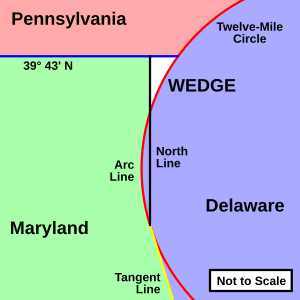
Delaware is 96 miles (154 km) long and ranges from 9 miles (14 km) to 35 miles (56 km) across, totaling 1,954 square miles (5,060 km2), making it the second-smallest state in the United States after Rhode Island. Delaware is bounded to the north by Pennsylvania; to the east by the Delaware River, Delaware Bay, New Jersey and the Atlantic Ocean; and to the west and south by Maryland. Small portions of Delaware are also situated on the eastern side of the Delaware River sharing land boundaries with New Jersey. The state of Delaware, together with the Eastern Shore counties of Maryland and two counties of Virginia, form the Delmarva Peninsula, which stretches down the Mid-Atlantic Coast.
The definition of the northern boundary of the state is unusual. Most of the boundary between Delaware and Pennsylvania was originally defined by an arc extending 12 miles (19.3 km) from the cupola of the courthouse in the city of New Castle.
This border extends all the way east to the low-tide mark on the New Jersey shore, then continues south along the shoreline until it again reaches the 12-mile (19 km) arc in the south; then the boundary continues in a more conventional way in the middle of the main channel (thalweg) of the Delaware River. To the west, a portion of the arc extends past the easternmost edge of Maryland. The remaining western border runs slightly east of due south from its intersection with the arc. The Wedge of land between the northwest part of the arc and the Maryland border was claimed by both Delaware and Pennsylvania until 1921, when Delaware's claim was confirmed.
Climate
Since almost all of Delaware is a part of the Atlantic coastal plain, the effects of the ocean moderate its climate. The state lies in the humid subtropical climate zone. Despite its small size (roughly 100 miles (160 km) from its northernmost to southernmost points), there is significant variation in mean temperature and amount of snowfall between Sussex County and New Castle County. Moderated by the Atlantic Ocean and Delaware Bay, the southern portion of the state has a milder climate and a longer growing season than the northern portion of the state. Delaware's all-time record high of 110 °F (43 °C) was recorded at Millsboro on July 21, 1930. The all-time record low of −17 °F (−27 °C) was also recorded at Millsboro on January 17, 1893.
Environment
The transitional climate of Delaware supports a wide variety of vegetation. In the northern third of the state are found Northeastern coastal forests and mixed oak forests typical of the northeastern United States. In the southern two-thirds of the state are found Middle Atlantic coastal forests. Trap Pond State Park, along with areas in other parts of Sussex County, for example, support the northernmost stands of bald cypress trees in North America.
Government
Delaware's fourth and current constitution, adopted in 1897, provides for executive, judicial and legislative branches.
Legislative branch
The Delaware General Assembly consists of a House of Representatives with 41 members and a Senate with 21 members. It sits in Dover, the state capital. Representatives are elected to two-year terms, while senators are elected to four-year terms. The Senate confirms judicial and other nominees appointed by the governor.
Judicial branch
The Delaware Constitution establishes a number of courts:
- The Delaware Supreme Court is the state's highest court.
- The Delaware Superior Court is the state's trial court of general jurisdiction.
- The Delaware Court of Chancery deals primarily in corporate disputes.
- The Family Court handles domestic and custody matters.
- The Delaware Court of Common Pleas has jurisdiction over a limited class of civil and criminal matters.
Minor non-constitutional courts include the Justice of the Peace Courts and Aldermen's Courts.
Significantly, Delaware has one of the few remaining Courts of Chancery in the nation, which has jurisdiction over equity cases, the vast majority of which are corporate disputes, many relating to mergers and acquisitions.
Delaware was the last U.S. state to use judicial corporal punishment, in 1952.
Executive branch
The executive branch is headed by the Governor of Delaware.The governor presents a "State of the State" speech to a joint session of the Delaware legislature annually.
The executive branch also consists of the Lieutenant governor, Attorney General of Delaware, the State Treasurer, the Auditor of Accounts and the Insurance Commissioner.
Counties
Delaware is subdivided into three counties; from north to south they are New Castle, Kent and Sussex. This is the fewest among all states. Each county elects its own legislative body (known in New Castle and Sussex counties as County Council, and in Kent County as Levy Court), which deal primarily in zoning and development issues. Most functions which are handled on a county-by-county basis in other states—such as court and law enforcement—have been centralized in Delaware, leading to a significant concentration of power in the Delaware state government. The counties were historically divided into hundreds, which were used as tax reporting and voting districts until the 1960s, but now serve no administrative role, their only current official legal use being in real estate title descriptions.
Municipalities
Wilmington is the state's largest city and its economic hub. It is located within commuting distance of both Philadelphia and Baltimore. All regions of Delaware are enjoying phenomenal growth, with Dover and the beach resorts expanding at a rapid rate.
CountiesCities
Towns |
Towns (cont.) |
Villages
Unincorporated places
|
Demographics
| Historical population | |||
|---|---|---|---|
| Census | Pop. | %± | |
| 1790 | 59,096 | — | |
| 1800 | 64,273 | 8.8% | |
| 1810 | 72,674 | 13.1% | |
| 1820 | 72,749 | 0.1% | |
| 1830 | 76,748 | 5.5% | |
| 1840 | 78,085 | 1.7% | |
| 1850 | 91,532 | 17.2% | |
| 1860 | 112,216 | 22.6% | |
| 1870 | 125,015 | 11.4% | |
| 1880 | 146,608 | 17.3% | |
| 1890 | 168,493 | 14.9% | |
| 1900 | 184,735 | 9.6% | |
| 1910 | 202,322 | 9.5% | |
| 1920 | 223,003 | 10.2% | |
| 1930 | 238,380 | 6.9% | |
| 1940 | 266,505 | 11.8% | |
| 1950 | 318,085 | 19.4% | |
| 1960 | 446,292 | 40.3% | |
| 1970 | 548,104 | 22.8% | |
| 1980 | 594,338 | 8.4% | |
| 1990 | 666,168 | 12.1% | |
| 2000 | 783,600 | 17.6% | |
| 2010 | 897,934 | 14.6% | |
| 2020 | 989,948 | 10.2% | |
| 2024 (est.) | 1,051,917 | 17.1% | |
| Source: 1910–2020 | |||
The United States Census Bureau determined that the population of Delaware was 989,948 on April 1, 2020, an increase from the 2010 census figure of 897,934.
Delaware's history as a border state has led it to exhibit characteristics of both the Northern and the Southern regions of the United States. Generally, the rural Southern (or "Slower Lower") regions of Delaware below the Chesapeake and Delaware Canal embody a Southern culture, while densely-populated Northern Delaware above the canal—particularly Wilmington, a part of the Philadelphia metropolitan area—has more in common with that of the Northeast and the North. The U.S. Census Bureau designates Delaware as one of the South Atlantic States, but it is commonly associated with the Mid-Atlantic States or northeastern United States by other federal agencies, the media, and some residents.
Delaware is the sixth most densely populated state, with a population density of 442.6 people per square mile, 356.4 per square mile more than the national average, and ranking 45th in population. Delaware is one of five U.S. states (Maine, Vermont, West Virginia, Wyoming) that do not have a single city with a population over 100,000 as of the 2010 census. The center of population of Delaware is in New Castle County, in the town of Townsend.
According to HUD's 2022 Annual Homeless Assessment Report, there were an estimated 2,369 homeless people in Delaware.
Race and ethnicity
According to the 2010 United States census, the racial composition of the state was 68.9% White American (65.3% Non-Hispanic White, 3.6% White Hispanic), 21.4% Black or African American, 0.5% American Indian and Alaska Native, 3.2% Asian American, 0.0% Native Hawaiian and other Pacific Islander, 3.4% some other race, and 2.7% of multiracial origin. People of Hispanic or Latino origin, of any race, made up 8.2% of the population.
The 2022 American Community Survey estimated the state had a racial and ethnic makeup of 60.6% non-Hispanic whites, 23.6% Black or African American, 0.7% American Indian or Alaska Native, 4.2% Asian, 0.1% Pacific Islander, 2.9% multiracial, and 10.1% Hispanic or Latin American of any race.
In the Native American community, the state has a Native American group, called in their own language Lenape, which was influential in the colonial period of the United States and is today headquartered in Cheswold, Kent County, Delaware. A band of the Nanticoke tribe of American Indians today resides in Sussex County and is headquartered in Millsboro, Sussex County, Delaware.
Delaware's population mainly consisted of people from the British Isles, African slaves, Germans and a few remaining Native Americans during the colonial era. Irish, Germans, Italians, Poles, and Russian Jewish immigrants were attracted by the industries in the Wilmington area. In the late 20th century a Puerto Rican community formed in Wilmington. Guatemalan people migrated to Sussex county to work in Delaware's poultry industry. A group of Native Americans in Delaware of mixed ethnicity, the Moors, live in Cheswold. The descendants of the Nanticoke people live around Millsboro. There is also a small numbers of Asians in New Castle county who work as scientific and engineering professionals.
| Racial composition | 1990 | 2000 | 2010 | 2020 |
|---|---|---|---|---|
| White | 80.3% | 74.6% | 68.9% | 60.4% |
| Black | 16.9% | 19.2% | 21.4% | 22.1% |
| Asian | 1.4% | 2.1% | 3.2% | 4.3% |
| Native | 0.3% | 0.4% | 0.5% | 0.5% |
| Native Hawaiian and other Pacific Islander |
– | – | – | - |
| Other race | 1.1% | 2.0% | 3.4% | 4.9% |
| Two or more races | – | 1.7% | 2.7% | 7.7% |
The top countries of origin for Delaware's immigrants in 2018 were Mexico, India, Guatemala, China, and Jamaica.
Languages
As of 2000, 91% of Delaware residents of age 5 and older spoke only English at home; 5% spoke Spanish. French was the third-most spoken language at 0.7%, followed by Chinese at 0.5% and German at 0.5%.
Legislation had been proposed in both the House and the Senate in Delaware to designate English as the official language. Neither bill was passed in the legislature.
Religion
| Religion in Delaware (2014) | ||||
|---|---|---|---|---|
| Religion | Percent | |||
| Protestant | 46% | |||
| None | 23% | |||
| Catholic | 22% | |||
| Jewish | 3% | |||
| Hindu | 2% | |||
| Other | 2% | |||
| Mormon | 1% | |||
| Muslim | 1% | |||
| Orthodox Christian | 1% | |||
As of 2014[update], Delaware is mostly Christian. Although Protestants account for almost half of the population, the Catholic Church is the largest single denomination in the state. The Association of Religion Data Archives reported in 2010 that the three largest denominational groups in Delaware by number of adherents are the Catholic Church at 182,532 adherents, the United Methodist Church with 53,656 members reported, and non-denominational Evangelical Protestant with 22,973 adherents reported. The religious body with the largest number of congregations is the United Methodist Church (with 158 congregations) followed by non-denominational Evangelical Protestant (with 106 congregations), then the Catholic Church (with 45 congregations).
The Roman Catholic Diocese of Wilmington and the Episcopal Diocese of Delaware oversee the parishes within their denominations. The A.U.M.P. Church, the oldest African-American denomination in the nation, was founded in Wilmington. It still has a substantial presence in the state. Reflecting new immigrant populations, an Islamic mosque has been built in the Ogletown area, and a Hindu temple in Hockessin.
Delaware is home to an Amish community which resides west of Dover in Kent County, consisting of nine church districts and about 1,650 people. The Amish first settled in Kent County in 1915. In recent years, increasing development has led to the decline in the number of Amish living in the community.
A 2012 survey of religious attitudes in the United States found that 34% of Delaware residents considered themselves "moderately religious", 33% "very religious", and 33% as "non-religious". At the 2014 Pew Research survey, 23% of the population were irreligious.
Economy
Affluence
| DE County | March 2010 | March 2011 |
|---|---|---|
| New Castle | 229,000 | 216,000 |
| Sussex | 323,000 | 296,000 |
| Kent | 186,000 | 178,000 |
According to a 2020 study by Kiplinger, Delaware had the 17th most millionaires per capita in the United States; altogether, there were 25,937 such individuals. The median income for Delaware households as of 2020 was $64,805.
Agriculture
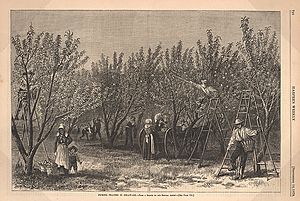
Delaware's agricultural output consists of poultry, nursery stock, soybeans, dairy products and corn.
Industries
As of October 2019[update], the state's unemployment rate was 3.7%.
The state's largest employers are:
- government (State of Delaware, New Castle County)
- education (University of Delaware, Delaware Technical Community College)
- banking (Bank of America, M&T Bank, JPMorgan Chase, Citigroup, Deutsche Bank)
- chemical, pharmaceutical, technology (DuPont de Nemours Inc., AstraZeneca, Syngenta, Agilent Technologies)
- healthcare (ChristianaCare (Christiana Hospital), Bayhealth Medical Center, Nemours Children's Hospital, Delaware)
- farming, specifically chicken farming in Sussex County (Perdue Farms, Mountaire Farms, Allen Family Foods)
- retail (Walmart, Walgreens, Acme Markets)
Industrial decline
Since the mid-2000s, Delaware has seen the departure of the state's automotive manufacturing industry (General Motors Wilmington Assembly and Chrysler Newark Assembly), the corporate buyout of a major bank holding company (MBNA), the departure of the state's steel industry (Evraz Claymont Steel), the bankruptcy of a fiber mill (National Vulcanized Fibre), and the diminishing presence of AstraZeneca in Wilmington.
In late 2015, DuPont announced that 1,700 employees, nearly a third of its footprint in Delaware, would be laid off in early 2016. The merger of E.I. du Pont de Nemours & Co. and Dow Chemical Company into DowDuPont took place on September 1, 2017.
Incorporation in Delaware
More than half of all U.S. publicly traded companies, and 63% of the Fortune 500, are incorporated in Delaware. The state's attractiveness as a corporate haven is largely because of its business-friendly corporation law. Franchise taxes on Delaware corporations supply about a fifth of the state's revenue. Although "USA (Delaware)" ranked as the world's most opaque jurisdiction on the Tax Justice Network's 2009 Financial Secrecy Index, the same group's 2011 Index ranks the U.S. fifth and does not specify Delaware. In Delaware, there are more than a million registered corporations, meaning there are more corporations than people.
Food and drink
Title 4, chapter 7 of the Delaware Code stipulates that alcoholic liquor be sold only in specifically licensed establishments, and only between 9:00 a.m. and 1:00 a.m. Until 2003, Delaware was among the several states enforcing blue laws and banned the sale of liquor on Sunday.
Media
Newspapers
Two daily newspapers are based in Delaware, the Delaware State News, based in Dover and covering the two southern counties, and The News Journal covering Wilmington and northern Delaware. The state is also served by several weekly, monthly and online publications.
Television
No standalone television stations are based solely in Delaware. The northern part of the state is served by network stations in Philadelphia and the southern part by network stations in Salisbury, Maryland. Philadelphia's ABC affiliate, WPVI-TV, maintains a news bureau in downtown Wilmington. Salisbury's CBS affiliate, WBOC-TV, maintains bureaus in Dover and Milton. Three Philadelphia-market stations—PBS member WHYY-TV, Ion affiliate WPPX, and MeTV affiliate WDPN-TV—all have Wilmington as their city of license, but maintain transmitters at the market antenna farm in Roxborough, Philadelphia and do not produce any Delaware-centric programming.
Radio
There are a numerous radio stations licensed in Delaware. WDDE 91.1 FM, WDEL 1150AM, WHGE-LP 95.3 FM, WILM 1450 AM, WVCW 99.5, WMPH 91.7 FM, WSTW 93.7 FM, WTMC 1380 AM and WWTX 1290AM are licensed from Wilmington. WRDX 92.9 FM is licensed from Smyrna. WDOV 1410AM, WDSD 94.7 FM and WRTX 91.7 FM are licensed from Dover.
Tourism

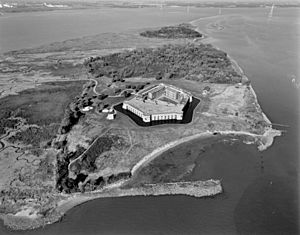
Delaware is home to First State National Historical Park, a National Park Service unit composed of historic sites across the state including the New Castle Court House, Green, and Sheriff's House, Dover Green, Beaver Valley, Fort Christina, Old Swedes' Church, John Dickinson Plantation, and the Ryves Holt House. Delaware has several museums, wildlife refuges, parks, houses, lighthouses, and other historic places.
Rehoboth Beach, together with the towns of Lewes, Dewey Beach, Bethany Beach, South Bethany, and Fenwick Island, comprise Delaware's beach resorts. Rehoboth Beach often bills itself as "The Nation's Summer Capital" because it is a frequent summer vacation destination for Washington, D.C., residents as well as visitors from Maryland, Virginia, and in lesser numbers, Pennsylvania. Vacationers are drawn for many reasons, including the town's charm, artistic appeal, nightlife, and tax-free shopping. According to SeaGrant Delaware, the Delaware beaches generate $6.9 billion annually and over $711 million in tax revenue.
Delaware is home to several festivals, fairs, and events. Some of the more notable festivals are the Riverfest held in Seaford, the World Championship Punkin Chunkin formerly held at various locations throughout the state since 1986, the Rehoboth Beach Chocolate Festival, the Bethany Beach Jazz Funeral to mark the end of summer, the Apple Scrapple Festival held in Bridgeville, the Clifford Brown Jazz Festival in Wilmington, the Rehoboth Beach Jazz Festival, the Sea Witch Halloween Festival and Parade in Rehoboth Beach, the Rehoboth Beach Independent Film Festival, the Nanticoke Indian Pow Wow in Oak Orchard, Firefly Music Festival, and the Return Day Parade held after every election in Georgetown.
In 2015, tourism in Delaware generated $3.1 billion, which makes up five percent of the state's GDP. Delaware saw 8.5 million visitors in 2015, with the tourism industry employing 41,730 people, making it the 4th largest private employer in the state. Major origin markets for Delaware tourists include Philadelphia, Baltimore, New York City, Washington, D.C., and Harrisburg, with 97% of tourists arriving to the state by car and 75% of tourists coming from a distance of 200 miles (320 km) or less.
Delaware is also home to two large sporting venues. Dover Motor Speedway is a race track in Dover, and Frawley Stadium in Wilmington is the home of the Wilmington Blue Rocks, a Minor League Baseball team that is currently affiliated with the Washington Nationals.
Education
In the early 1920s, Pierre S. du Pont served as president of the state board of education. At the time, state law prohibited money raised from white taxpayers from being used to support the state's schools for black children. Appalled by the condition of the black schools, du Pont donated four million dollars to construct 86 new school buildings.
Delaware was the origin of Belton v. Gebhart (1952), one of the four cases which were combined into Brown v. Board of Education, the Supreme Court of the United States decision that led to the end of officially segregated public schools. Significantly, Belton was the only case in which the state court found for the plaintiffs, thereby ruling that segregation is unconstitutional.
Unlike many states, Delaware's educational system is centralized in a state Superintendent of Education, with local school boards retaining control over taxation and some curriculum decisions. This centralized system, combined with the small size of the state, likely contributed to Delaware becoming the first state, after completion of a three-year, $30 million program ending in 1999, to wire every K-12 classroom in the state to the Internet.
As of 2011[update], the Delaware Department of Education had authorized the founding of 25 charter schools in the state, one of them being all-girls.
All teachers in the State's public school districts are unionized. As of January 2012[update], none of the State's charter schools are members of a teachers union. One of the State's teachers' unions is Delaware State Education Association (DSEA).
Colleges and universities
- Delaware College of Art and Design
- Delaware State University
- Delaware Technical & Community College
- Goldey-Beacom College
- University of Delaware—Ranked 63rd in the U.S. and in top 201–250 in the world (Times Higher Education World University Rankings 2018)
- Widener University School of Law
- Wilmington University
Transportation
The transportation system in Delaware is under the governance and supervision of the Delaware Department of Transportation (DelDOT). Funding for DelDOT projects is drawn, in part, from the Delaware Transportation Trust Fund, established in 1987 to help stabilize transportation funding; the availability of the Trust led to a gradual separation of DelDOT operations from other Delaware state operations. DelDOT manages programs such as a Delaware Adopt-a-Highway program, major road route snow removal, traffic control infrastructure (signs and signals), toll road management, Delaware Division of Motor Vehicles, the Delaware Transit Corporation (branded as "DART First State", the state government public transportation organization), and others.
In 2009, DelDOT maintained 13,507 lane-miles, totaling 89 percent of the state's public roadway system, the rest being under the supervision of individual municipalities. This far exceeds the national average (20 percent) for state department of transportation maintenance responsibility.
Roads
One major branch of the U.S. Interstate Highway System, Interstate 95 (I-95), crosses Delaware southwest-to-northeast across New Castle County. Two Auxiliary Interstate Highway routes are also located in the state. Interstate 495 (I-495) is an eastern bypass of Wilmington. Interstate 295 (I-295) is a bypass of Philadelphia which begins south of Wilmington. In addition to Interstate highways, there are six U.S. highways that serve Delaware: U.S. 9, U.S. 13, U.S. 40, U.S. 113, U.S. 202, and U.S. 301. There are also several state highways that cross the state of Delaware; a few of them include DE 1, DE 9, and DE 404. U.S. 13 and DE 1 are primary north–south highways connecting Wilmington and Pennsylvania with Maryland, with DE 1 serving as the main route between Wilmington and the Delaware beaches. DE 9 is a north–south highway connecting Dover and Wilmington via a scenic route along the Delaware Bay. U.S. 40 is a primary east–west route, connecting Maryland with New Jersey. DE 404 is another primary east–west highway connecting the Chesapeake Bay Bridge in Maryland with the Delaware beaches. The state also operates three toll highways, the Delaware Turnpike, which is I-95, between Maryland and New Castle; the Korean War Veterans Memorial Highway, which is DE 1, between Wilmington and Dover; and the U.S. 301 toll road between the Maryland border and DE 1 in New Castle County.
A bicycle route, Delaware Bicycle Route 1, spans the north–south length of the state from the Maryland border in Fenwick Island to the Pennsylvania border north of Montchanin. It is the first of several signed bike routes planned in Delaware.
Delaware has about 875 bridges, 95 percent of which are under the supervision of DelDOT. About 30 percent of all Delaware bridges were built before 1950, and about 60 percent of the number are included in the National Bridge Inventory. Some bridges not under DelDOT supervision includes the four bridges on the Chesapeake and Delaware Canal, which are under the jurisdiction of the U.S. Army Corps of Engineers, and the Delaware Memorial Bridge, which is under the bi-state Delaware River and Bay Authority.
It has been noted that the tar and chip composition of secondary roads in Sussex County makes them more prone to deterioration than are the asphalt roadways in almost the rest of the state. Among these roads, Sussex (county road) 236 is among the most problematic.
Ferries
Three ferries operate in the state of Delaware:
- Cape May–Lewes Ferry crosses the mouth of Delaware Bay between Lewes, Delaware and Cape May, New Jersey.
- Woodland Ferry (a cable ferry) crosses the Nanticoke River southwest of Seaford.
- Forts Ferry Crossing connects Delaware City with Fort Delaware and Fort Mott, New Jersey.
Rail and bus
Amtrak has two stations in Delaware along the Northeast Corridor; the relatively quiet Newark Rail Station in Newark, and the busier Wilmington Station in Wilmington. The Northeast Corridor is also served by SEPTA's Wilmington/Newark Line, part of SEPTA Regional Rail, which serves Claymont, Wilmington, Churchmans Crossing, and Newark.
Two Class I railroads, Norfolk Southern and CSX, provide freight rail service in northern New Castle County. Norfolk Southern provides freight service along the Northeast Corridor and to industrial areas in Edgemoor, New Castle, and Delaware City. CSX's Philadelphia Subdivision passes through northern New Castle County parallel to the Amtrak Northeast Corridor. Multiple short-line railroads provide freight service in Delaware. The Delmarva Central Railroad operates the most trackage of the short-line railroads, running from an interchange with Norfolk Southern in Porter south through Dover, Harrington, and Seaford to Delmar, with another line running from Harrington to Frankford and branches from Ellendale to Milton and from Georgetown to Gravel Hill. The Delmarva Central Railroad connects with the Maryland and Delaware Railroad, which serves local customers in Sussex County. CSX connects with the freight/heritage operation, the Wilmington and Western Railroad, based in Wilmington and the East Penn Railroad, which operates a line from Wilmington to Coatesville, Pennsylvania.
The last north–south passenger trains through the main part of Delaware was the Pennsylvania Railroad's local Wilmington-Delmar train in 1965. This was a successor to the Del-Mar-Va Express and Cavalier, which had run from Philadelphia through the state's interior, to the end of the Delmarva Peninsula until the mid-1950s.
The DART First State public transportation system was named "Most Outstanding Public Transportation System" in 2003 by the American Public Transportation Association. Coverage of the system is broad within northern New Castle County with close association to major highways in Kent and Sussex counties. The system includes bus, subsidized passenger rail operated by Philadelphia transit agency SEPTA, and subsidized taxi and paratransit modes. The paratransit system, consisting of a statewide door-to-door bus service for the elderly and disabled, has been described by a Delaware state report as "the most generous paratransit system in the United States". As of 2012[update], fees for the paratransit service have not changed since 1988.
Air
As of 2023[update], Delaware is served exclusively by Avelo Airlines out of Wilmington Airport, launching five routes to Florida on February 1. This put an end to an eight-month period during which Delaware had no scheduled air service, one of several since 1991. Various airlines had served Wilmington Airport, the latest departure being Frontier Airlines in June 2022.
Delaware is centrally situated in the Northeast megalopolis region of cities along I-95. Therefore, Delaware commercial airline passengers most frequently use Philadelphia International Airport (PHL), Baltimore-Washington International Thurgood Marshall Airport (BWI) and Washington Dulles International Airport (IAD) for domestic and international transit. Residents of Sussex County will also use Wicomico Regional Airport (SBY), as it is located less than 10 miles (16 km) from the Delaware border. Atlantic City International Airport (ACY), Newark Liberty International Airport (EWR), and Ronald Reagan Washington National Airport (DCA) are also within a 100-mile (160 km) radius of New Castle County.
Other general aviation airports in Delaware include Summit Airport near Middletown, Delaware Airpark near Cheswold, and Delaware Coastal Airport near Georgetown.
Dover Air Force Base, one of the largest in the country, is home to the 436th Airlift Wing and the 512th Airlift Wing. In addition to its other responsibilities in the Air Mobility Command, it serves as the entry point and mortuary for U.S. military personnel (and some civilians) who die overseas.
Culture and entertainment
Festivals
Sports
- Professional teams
| Team | Sport | League |
|---|---|---|
| Delaware Black Foxes | Rugby League | USA Rugby League |
| Delaware Blue Coats | Basketball | NBA G League |
| Delaware Thunder | Hockey | Federal Prospects Hockey League |
| Diamond State Roller Girls | Roller derby | Women's Flat Track Derby Association |
| Wilmington Blue Rocks | Baseball | High-A East |
As Delaware has no franchises in the major American professional sports leagues, many Delawareans follow either Philadelphia or Baltimore teams. In the WNBA, the Washington Mystics enjoy a major following due to the presence of Wilmington native and University of Delaware product Elena Delle Donne. The University of Delaware's football team has a large following throughout the state, with the Delaware State University and Wesley College teams also enjoying a smaller degree of support.
Delaware is home to Dover Motor Speedway and Bally's Dover. Dover Motor Speedway, also known as the Monster Mile, is one of only 10 tracks in the nation to have hosted 100 or more NASCAR Cup Series races. Bally's Dover is a popular harness racing facility. It is the only co-located horse- and car-racing facility in the nation, with the Bally's Dover track located inside the Dover Motor Speedway track.
Delaware is represented in rugby by the Delaware Black Foxes, a 2015 expansion club.
Delaware has been home to professional wrestling outfit Combat Zone Wrestling (CZW). CZW has been affiliated with the annual Tournament of Death and ECWA with its annual Super 8 Tournament.
Delaware's official state sport is bicycling.
Foreign Affairs
Sister State
Delaware has had a foreign sister state in Japan, named Miyagi Prefecture. These two have shared relations since 1997, and have had exchange programs available for students that were briefly paused in wake of the earthquake and the tsunami that ensued in the prefecture during March 2011.
Delawareans
Prominent Delawareans include the du Pont family of politicians and businesspersons, and the 46th and current president of the United States Joe Biden, whose family moved to Delaware during his childhood, and who later represented Delaware for 36 years in the United States Senate before becoming the 47th vice president of the United States.
See also
 In Spanish: Delaware para niños
In Spanish: Delaware para niños



